Guidelines for Implementing Culturally Competent Nursing Care
VerifiedAdded on 2021/04/17
|13
|3455
|153
AI Summary
The provided assignment details a compilation of research articles related to nursing care and health management. The papers discuss various aspects such as culturally competent nursing care, hypertension management, and the use of mobile health technology. A content analysis of smartphone-based applications for hypertension management is also presented, along with an update on standardized hypertension management to reduce cardiovascular disease morbidity and mortality worldwide.
Contribute Materials
Your contribution can guide someone’s learning journey. Share your
documents today.
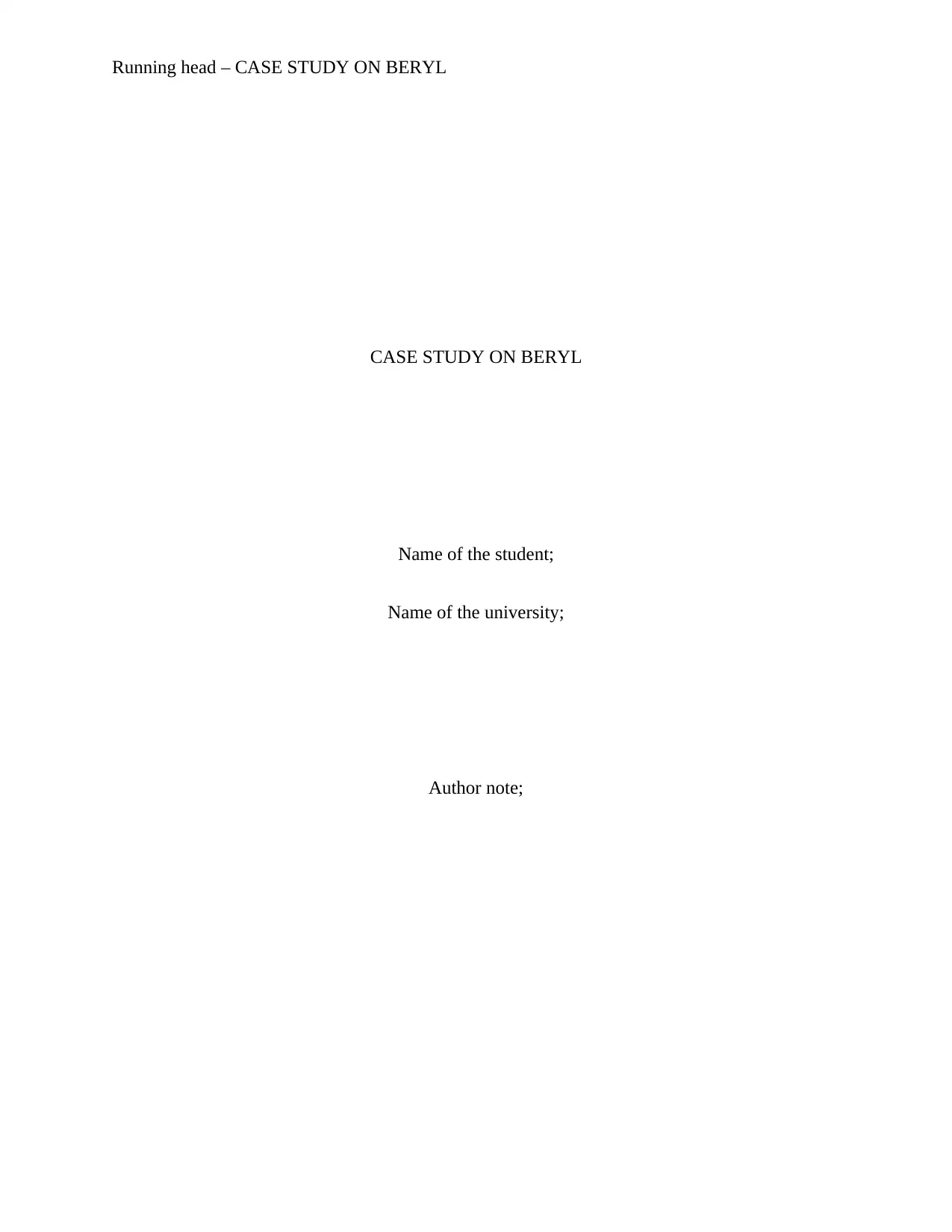
Running head – CASE STUDY ON BERYL
CASE STUDY ON BERYL
Name of the student;
Name of the university;
Author note;
CASE STUDY ON BERYL
Name of the student;
Name of the university;
Author note;
Secure Best Marks with AI Grader
Need help grading? Try our AI Grader for instant feedback on your assignments.
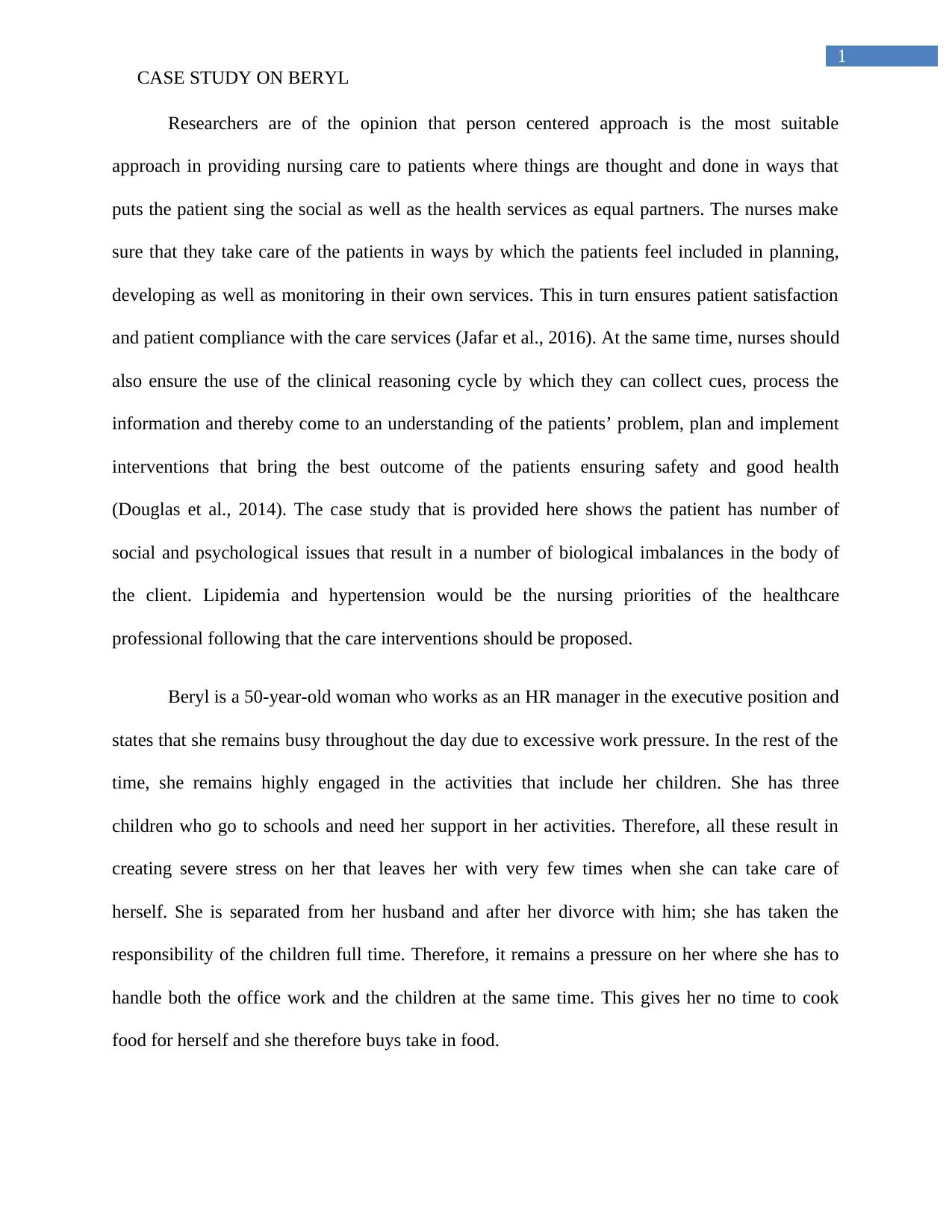
1
CASE STUDY ON BERYL
Researchers are of the opinion that person centered approach is the most suitable
approach in providing nursing care to patients where things are thought and done in ways that
puts the patient sing the social as well as the health services as equal partners. The nurses make
sure that they take care of the patients in ways by which the patients feel included in planning,
developing as well as monitoring in their own services. This in turn ensures patient satisfaction
and patient compliance with the care services (Jafar et al., 2016). At the same time, nurses should
also ensure the use of the clinical reasoning cycle by which they can collect cues, process the
information and thereby come to an understanding of the patients’ problem, plan and implement
interventions that bring the best outcome of the patients ensuring safety and good health
(Douglas et al., 2014). The case study that is provided here shows the patient has number of
social and psychological issues that result in a number of biological imbalances in the body of
the client. Lipidemia and hypertension would be the nursing priorities of the healthcare
professional following that the care interventions should be proposed.
Beryl is a 50-year-old woman who works as an HR manager in the executive position and
states that she remains busy throughout the day due to excessive work pressure. In the rest of the
time, she remains highly engaged in the activities that include her children. She has three
children who go to schools and need her support in her activities. Therefore, all these result in
creating severe stress on her that leaves her with very few times when she can take care of
herself. She is separated from her husband and after her divorce with him; she has taken the
responsibility of the children full time. Therefore, it remains a pressure on her where she has to
handle both the office work and the children at the same time. This gives her no time to cook
food for herself and she therefore buys take in food.
CASE STUDY ON BERYL
Researchers are of the opinion that person centered approach is the most suitable
approach in providing nursing care to patients where things are thought and done in ways that
puts the patient sing the social as well as the health services as equal partners. The nurses make
sure that they take care of the patients in ways by which the patients feel included in planning,
developing as well as monitoring in their own services. This in turn ensures patient satisfaction
and patient compliance with the care services (Jafar et al., 2016). At the same time, nurses should
also ensure the use of the clinical reasoning cycle by which they can collect cues, process the
information and thereby come to an understanding of the patients’ problem, plan and implement
interventions that bring the best outcome of the patients ensuring safety and good health
(Douglas et al., 2014). The case study that is provided here shows the patient has number of
social and psychological issues that result in a number of biological imbalances in the body of
the client. Lipidemia and hypertension would be the nursing priorities of the healthcare
professional following that the care interventions should be proposed.
Beryl is a 50-year-old woman who works as an HR manager in the executive position and
states that she remains busy throughout the day due to excessive work pressure. In the rest of the
time, she remains highly engaged in the activities that include her children. She has three
children who go to schools and need her support in her activities. Therefore, all these result in
creating severe stress on her that leaves her with very few times when she can take care of
herself. She is separated from her husband and after her divorce with him; she has taken the
responsibility of the children full time. Therefore, it remains a pressure on her where she has to
handle both the office work and the children at the same time. This gives her no time to cook
food for herself and she therefore buys take in food.
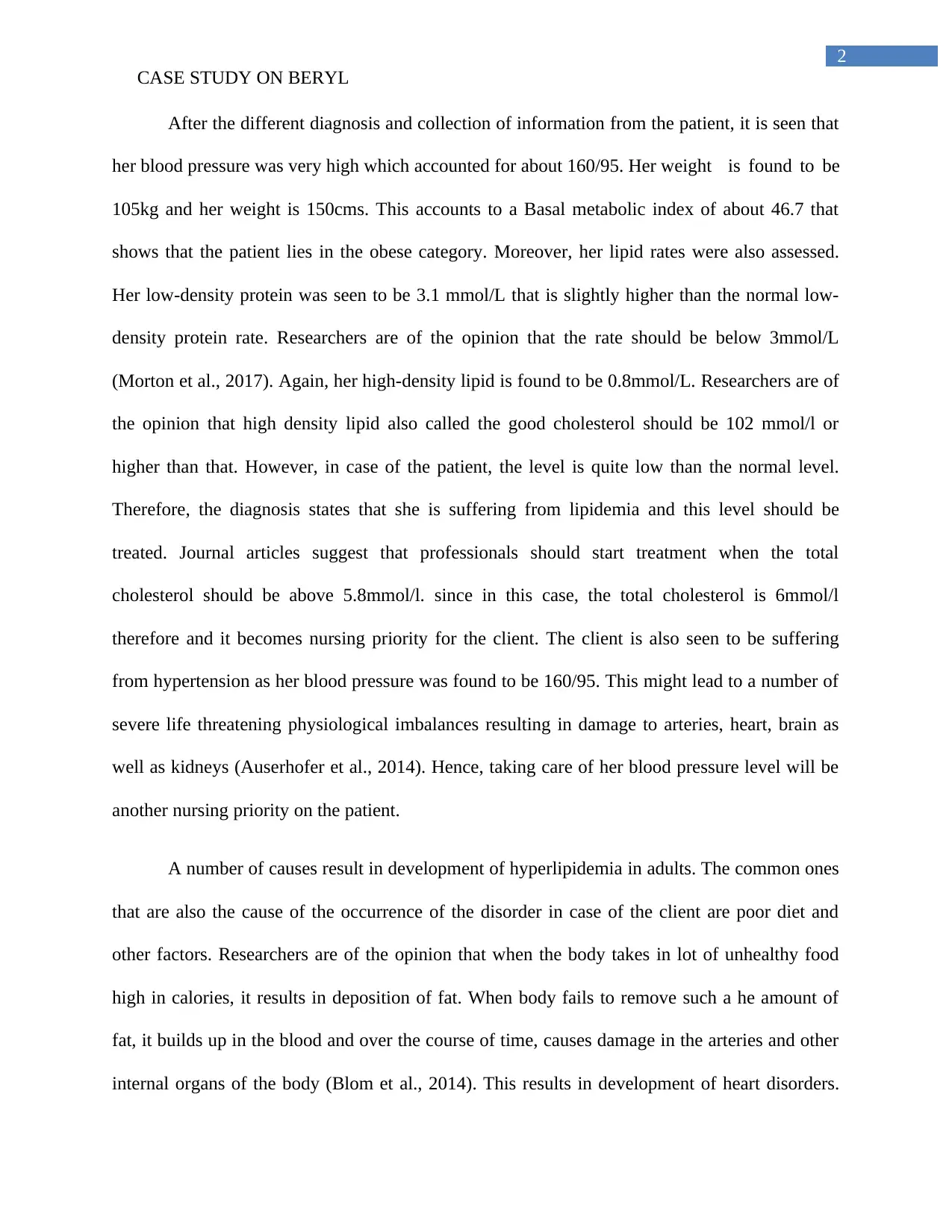
2
CASE STUDY ON BERYL
After the different diagnosis and collection of information from the patient, it is seen that
her blood pressure was very high which accounted for about 160/95. Her weight is found to be
105kg and her weight is 150cms. This accounts to a Basal metabolic index of about 46.7 that
shows that the patient lies in the obese category. Moreover, her lipid rates were also assessed.
Her low-density protein was seen to be 3.1 mmol/L that is slightly higher than the normal low-
density protein rate. Researchers are of the opinion that the rate should be below 3mmol/L
(Morton et al., 2017). Again, her high-density lipid is found to be 0.8mmol/L. Researchers are of
the opinion that high density lipid also called the good cholesterol should be 102 mmol/l or
higher than that. However, in case of the patient, the level is quite low than the normal level.
Therefore, the diagnosis states that she is suffering from lipidemia and this level should be
treated. Journal articles suggest that professionals should start treatment when the total
cholesterol should be above 5.8mmol/l. since in this case, the total cholesterol is 6mmol/l
therefore and it becomes nursing priority for the client. The client is also seen to be suffering
from hypertension as her blood pressure was found to be 160/95. This might lead to a number of
severe life threatening physiological imbalances resulting in damage to arteries, heart, brain as
well as kidneys (Auserhofer et al., 2014). Hence, taking care of her blood pressure level will be
another nursing priority on the patient.
A number of causes result in development of hyperlipidemia in adults. The common ones
that are also the cause of the occurrence of the disorder in case of the client are poor diet and
other factors. Researchers are of the opinion that when the body takes in lot of unhealthy food
high in calories, it results in deposition of fat. When body fails to remove such a he amount of
fat, it builds up in the blood and over the course of time, causes damage in the arteries and other
internal organs of the body (Blom et al., 2014). This results in development of heart disorders.
CASE STUDY ON BERYL
After the different diagnosis and collection of information from the patient, it is seen that
her blood pressure was very high which accounted for about 160/95. Her weight is found to be
105kg and her weight is 150cms. This accounts to a Basal metabolic index of about 46.7 that
shows that the patient lies in the obese category. Moreover, her lipid rates were also assessed.
Her low-density protein was seen to be 3.1 mmol/L that is slightly higher than the normal low-
density protein rate. Researchers are of the opinion that the rate should be below 3mmol/L
(Morton et al., 2017). Again, her high-density lipid is found to be 0.8mmol/L. Researchers are of
the opinion that high density lipid also called the good cholesterol should be 102 mmol/l or
higher than that. However, in case of the patient, the level is quite low than the normal level.
Therefore, the diagnosis states that she is suffering from lipidemia and this level should be
treated. Journal articles suggest that professionals should start treatment when the total
cholesterol should be above 5.8mmol/l. since in this case, the total cholesterol is 6mmol/l
therefore and it becomes nursing priority for the client. The client is also seen to be suffering
from hypertension as her blood pressure was found to be 160/95. This might lead to a number of
severe life threatening physiological imbalances resulting in damage to arteries, heart, brain as
well as kidneys (Auserhofer et al., 2014). Hence, taking care of her blood pressure level will be
another nursing priority on the patient.
A number of causes result in development of hyperlipidemia in adults. The common ones
that are also the cause of the occurrence of the disorder in case of the client are poor diet and
other factors. Researchers are of the opinion that when the body takes in lot of unhealthy food
high in calories, it results in deposition of fat. When body fails to remove such a he amount of
fat, it builds up in the blood and over the course of time, causes damage in the arteries and other
internal organs of the body (Blom et al., 2014). This results in development of heart disorders.
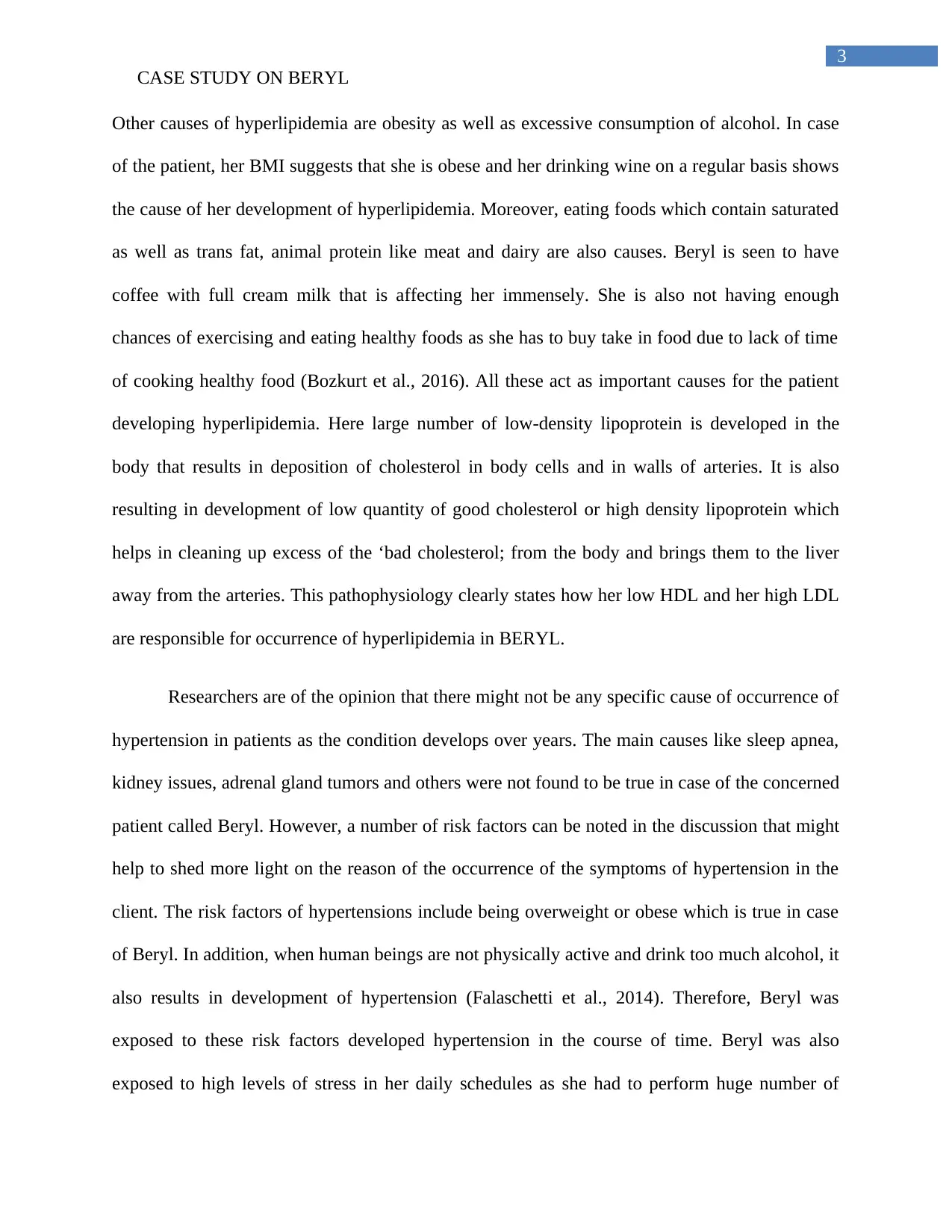
3
CASE STUDY ON BERYL
Other causes of hyperlipidemia are obesity as well as excessive consumption of alcohol. In case
of the patient, her BMI suggests that she is obese and her drinking wine on a regular basis shows
the cause of her development of hyperlipidemia. Moreover, eating foods which contain saturated
as well as trans fat, animal protein like meat and dairy are also causes. Beryl is seen to have
coffee with full cream milk that is affecting her immensely. She is also not having enough
chances of exercising and eating healthy foods as she has to buy take in food due to lack of time
of cooking healthy food (Bozkurt et al., 2016). All these act as important causes for the patient
developing hyperlipidemia. Here large number of low-density lipoprotein is developed in the
body that results in deposition of cholesterol in body cells and in walls of arteries. It is also
resulting in development of low quantity of good cholesterol or high density lipoprotein which
helps in cleaning up excess of the ‘bad cholesterol; from the body and brings them to the liver
away from the arteries. This pathophysiology clearly states how her low HDL and her high LDL
are responsible for occurrence of hyperlipidemia in BERYL.
Researchers are of the opinion that there might not be any specific cause of occurrence of
hypertension in patients as the condition develops over years. The main causes like sleep apnea,
kidney issues, adrenal gland tumors and others were not found to be true in case of the concerned
patient called Beryl. However, a number of risk factors can be noted in the discussion that might
help to shed more light on the reason of the occurrence of the symptoms of hypertension in the
client. The risk factors of hypertensions include being overweight or obese which is true in case
of Beryl. In addition, when human beings are not physically active and drink too much alcohol, it
also results in development of hypertension (Falaschetti et al., 2014). Therefore, Beryl was
exposed to these risk factors developed hypertension in the course of time. Beryl was also
exposed to high levels of stress in her daily schedules as she had to perform huge number of
CASE STUDY ON BERYL
Other causes of hyperlipidemia are obesity as well as excessive consumption of alcohol. In case
of the patient, her BMI suggests that she is obese and her drinking wine on a regular basis shows
the cause of her development of hyperlipidemia. Moreover, eating foods which contain saturated
as well as trans fat, animal protein like meat and dairy are also causes. Beryl is seen to have
coffee with full cream milk that is affecting her immensely. She is also not having enough
chances of exercising and eating healthy foods as she has to buy take in food due to lack of time
of cooking healthy food (Bozkurt et al., 2016). All these act as important causes for the patient
developing hyperlipidemia. Here large number of low-density lipoprotein is developed in the
body that results in deposition of cholesterol in body cells and in walls of arteries. It is also
resulting in development of low quantity of good cholesterol or high density lipoprotein which
helps in cleaning up excess of the ‘bad cholesterol; from the body and brings them to the liver
away from the arteries. This pathophysiology clearly states how her low HDL and her high LDL
are responsible for occurrence of hyperlipidemia in BERYL.
Researchers are of the opinion that there might not be any specific cause of occurrence of
hypertension in patients as the condition develops over years. The main causes like sleep apnea,
kidney issues, adrenal gland tumors and others were not found to be true in case of the concerned
patient called Beryl. However, a number of risk factors can be noted in the discussion that might
help to shed more light on the reason of the occurrence of the symptoms of hypertension in the
client. The risk factors of hypertensions include being overweight or obese which is true in case
of Beryl. In addition, when human beings are not physically active and drink too much alcohol, it
also results in development of hypertension (Falaschetti et al., 2014). Therefore, Beryl was
exposed to these risk factors developed hypertension in the course of time. Beryl was also
exposed to high levels of stress in her daily schedules as she had to perform huge number of
Secure Best Marks with AI Grader
Need help grading? Try our AI Grader for instant feedback on your assignments.
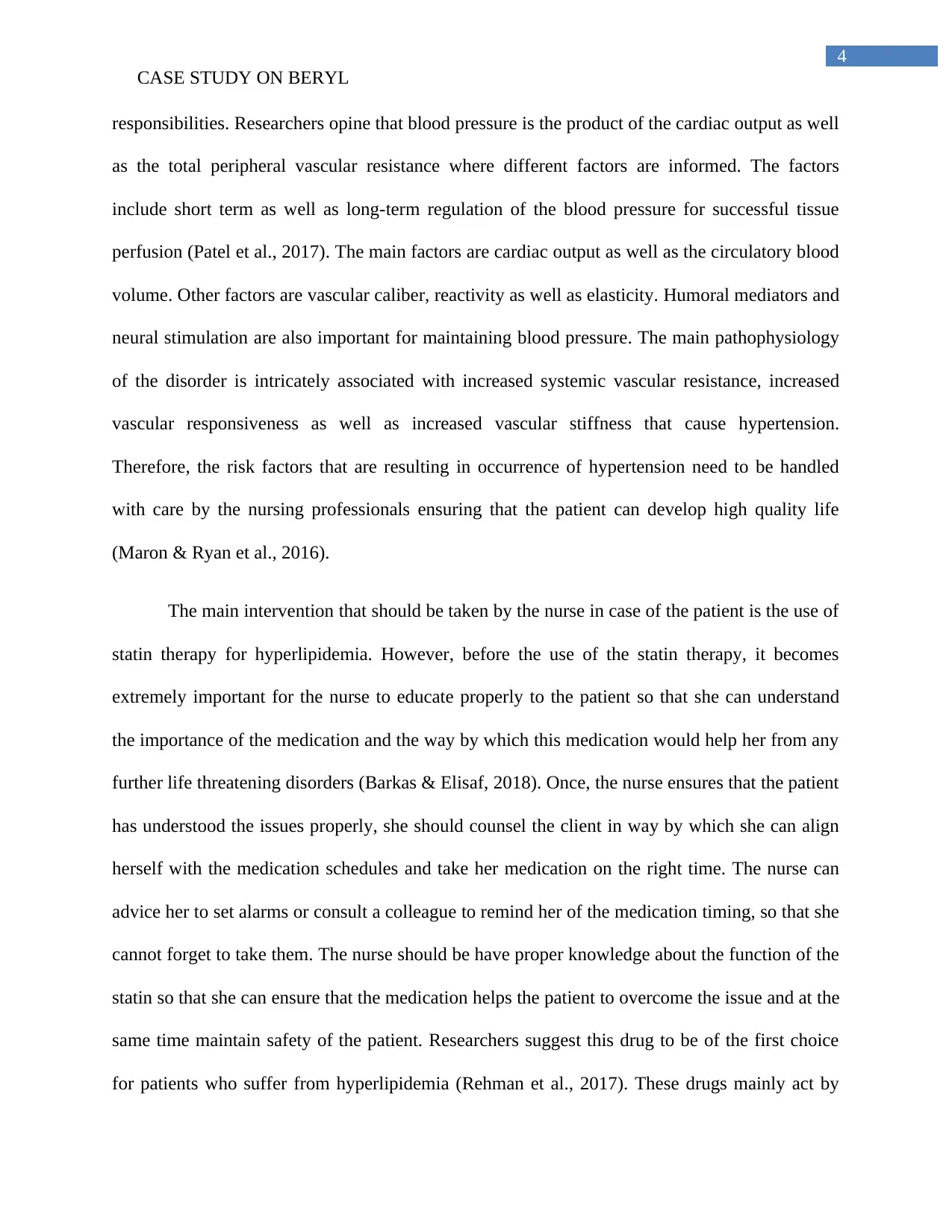
4
CASE STUDY ON BERYL
responsibilities. Researchers opine that blood pressure is the product of the cardiac output as well
as the total peripheral vascular resistance where different factors are informed. The factors
include short term as well as long-term regulation of the blood pressure for successful tissue
perfusion (Patel et al., 2017). The main factors are cardiac output as well as the circulatory blood
volume. Other factors are vascular caliber, reactivity as well as elasticity. Humoral mediators and
neural stimulation are also important for maintaining blood pressure. The main pathophysiology
of the disorder is intricately associated with increased systemic vascular resistance, increased
vascular responsiveness as well as increased vascular stiffness that cause hypertension.
Therefore, the risk factors that are resulting in occurrence of hypertension need to be handled
with care by the nursing professionals ensuring that the patient can develop high quality life
(Maron & Ryan et al., 2016).
The main intervention that should be taken by the nurse in case of the patient is the use of
statin therapy for hyperlipidemia. However, before the use of the statin therapy, it becomes
extremely important for the nurse to educate properly to the patient so that she can understand
the importance of the medication and the way by which this medication would help her from any
further life threatening disorders (Barkas & Elisaf, 2018). Once, the nurse ensures that the patient
has understood the issues properly, she should counsel the client in way by which she can align
herself with the medication schedules and take her medication on the right time. The nurse can
advice her to set alarms or consult a colleague to remind her of the medication timing, so that she
cannot forget to take them. The nurse should be have proper knowledge about the function of the
statin so that she can ensure that the medication helps the patient to overcome the issue and at the
same time maintain safety of the patient. Researchers suggest this drug to be of the first choice
for patients who suffer from hyperlipidemia (Rehman et al., 2017). These drugs mainly act by
CASE STUDY ON BERYL
responsibilities. Researchers opine that blood pressure is the product of the cardiac output as well
as the total peripheral vascular resistance where different factors are informed. The factors
include short term as well as long-term regulation of the blood pressure for successful tissue
perfusion (Patel et al., 2017). The main factors are cardiac output as well as the circulatory blood
volume. Other factors are vascular caliber, reactivity as well as elasticity. Humoral mediators and
neural stimulation are also important for maintaining blood pressure. The main pathophysiology
of the disorder is intricately associated with increased systemic vascular resistance, increased
vascular responsiveness as well as increased vascular stiffness that cause hypertension.
Therefore, the risk factors that are resulting in occurrence of hypertension need to be handled
with care by the nursing professionals ensuring that the patient can develop high quality life
(Maron & Ryan et al., 2016).
The main intervention that should be taken by the nurse in case of the patient is the use of
statin therapy for hyperlipidemia. However, before the use of the statin therapy, it becomes
extremely important for the nurse to educate properly to the patient so that she can understand
the importance of the medication and the way by which this medication would help her from any
further life threatening disorders (Barkas & Elisaf, 2018). Once, the nurse ensures that the patient
has understood the issues properly, she should counsel the client in way by which she can align
herself with the medication schedules and take her medication on the right time. The nurse can
advice her to set alarms or consult a colleague to remind her of the medication timing, so that she
cannot forget to take them. The nurse should be have proper knowledge about the function of the
statin so that she can ensure that the medication helps the patient to overcome the issue and at the
same time maintain safety of the patient. Researchers suggest this drug to be of the first choice
for patients who suffer from hyperlipidemia (Rehman et al., 2017). These drugs mainly act by
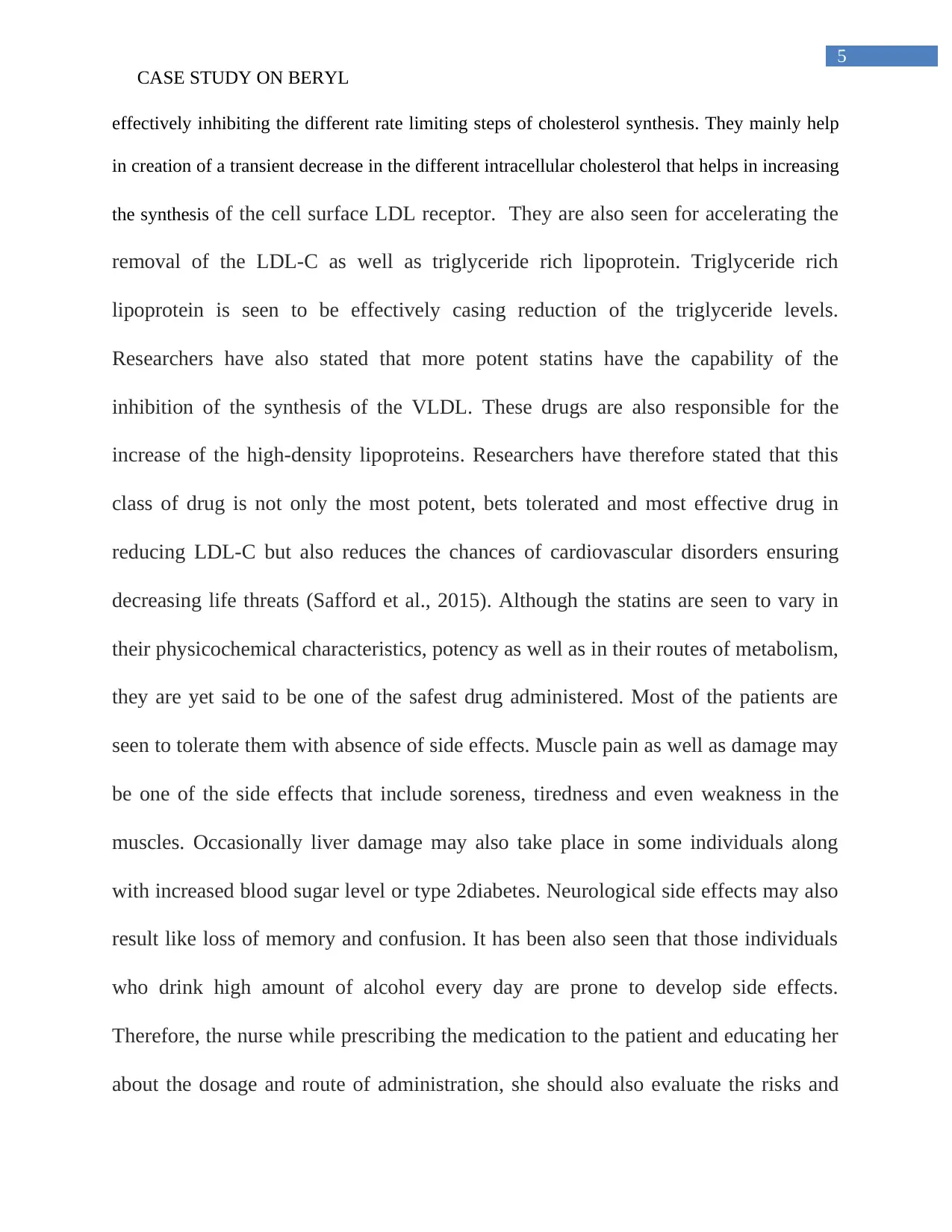
5
CASE STUDY ON BERYL
effectively inhibiting the different rate limiting steps of cholesterol synthesis. They mainly help
in creation of a transient decrease in the different intracellular cholesterol that helps in increasing
the synthesis of the cell surface LDL receptor. They are also seen for accelerating the
removal of the LDL-C as well as triglyceride rich lipoprotein. Triglyceride rich
lipoprotein is seen to be effectively casing reduction of the triglyceride levels.
Researchers have also stated that more potent statins have the capability of the
inhibition of the synthesis of the VLDL. These drugs are also responsible for the
increase of the high-density lipoproteins. Researchers have therefore stated that this
class of drug is not only the most potent, bets tolerated and most effective drug in
reducing LDL-C but also reduces the chances of cardiovascular disorders ensuring
decreasing life threats (Safford et al., 2015). Although the statins are seen to vary in
their physicochemical characteristics, potency as well as in their routes of metabolism,
they are yet said to be one of the safest drug administered. Most of the patients are
seen to tolerate them with absence of side effects. Muscle pain as well as damage may
be one of the side effects that include soreness, tiredness and even weakness in the
muscles. Occasionally liver damage may also take place in some individuals along
with increased blood sugar level or type 2diabetes. Neurological side effects may also
result like loss of memory and confusion. It has been also seen that those individuals
who drink high amount of alcohol every day are prone to develop side effects.
Therefore, the nurse while prescribing the medication to the patient and educating her
about the dosage and route of administration, she should also evaluate the risks and
CASE STUDY ON BERYL
effectively inhibiting the different rate limiting steps of cholesterol synthesis. They mainly help
in creation of a transient decrease in the different intracellular cholesterol that helps in increasing
the synthesis of the cell surface LDL receptor. They are also seen for accelerating the
removal of the LDL-C as well as triglyceride rich lipoprotein. Triglyceride rich
lipoprotein is seen to be effectively casing reduction of the triglyceride levels.
Researchers have also stated that more potent statins have the capability of the
inhibition of the synthesis of the VLDL. These drugs are also responsible for the
increase of the high-density lipoproteins. Researchers have therefore stated that this
class of drug is not only the most potent, bets tolerated and most effective drug in
reducing LDL-C but also reduces the chances of cardiovascular disorders ensuring
decreasing life threats (Safford et al., 2015). Although the statins are seen to vary in
their physicochemical characteristics, potency as well as in their routes of metabolism,
they are yet said to be one of the safest drug administered. Most of the patients are
seen to tolerate them with absence of side effects. Muscle pain as well as damage may
be one of the side effects that include soreness, tiredness and even weakness in the
muscles. Occasionally liver damage may also take place in some individuals along
with increased blood sugar level or type 2diabetes. Neurological side effects may also
result like loss of memory and confusion. It has been also seen that those individuals
who drink high amount of alcohol every day are prone to develop side effects.
Therefore, the nurse while prescribing the medication to the patient and educating her
about the dosage and route of administration, she should also evaluate the risks and
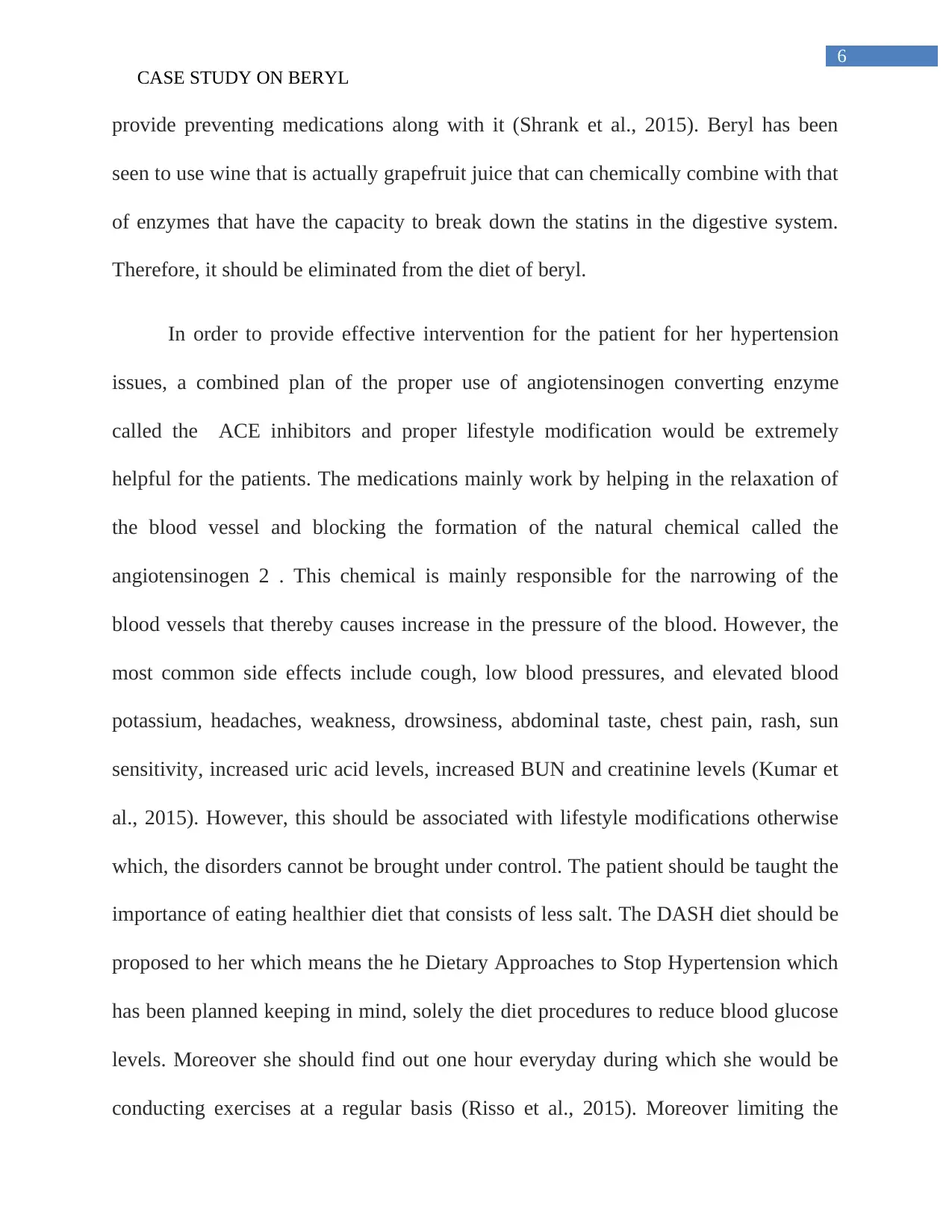
6
CASE STUDY ON BERYL
provide preventing medications along with it (Shrank et al., 2015). Beryl has been
seen to use wine that is actually grapefruit juice that can chemically combine with that
of enzymes that have the capacity to break down the statins in the digestive system.
Therefore, it should be eliminated from the diet of beryl.
In order to provide effective intervention for the patient for her hypertension
issues, a combined plan of the proper use of angiotensinogen converting enzyme
called the ACE inhibitors and proper lifestyle modification would be extremely
helpful for the patients. The medications mainly work by helping in the relaxation of
the blood vessel and blocking the formation of the natural chemical called the
angiotensinogen 2 . This chemical is mainly responsible for the narrowing of the
blood vessels that thereby causes increase in the pressure of the blood. However, the
most common side effects include cough, low blood pressures, and elevated blood
potassium, headaches, weakness, drowsiness, abdominal taste, chest pain, rash, sun
sensitivity, increased uric acid levels, increased BUN and creatinine levels (Kumar et
al., 2015). However, this should be associated with lifestyle modifications otherwise
which, the disorders cannot be brought under control. The patient should be taught the
importance of eating healthier diet that consists of less salt. The DASH diet should be
proposed to her which means the he Dietary Approaches to Stop Hypertension which
has been planned keeping in mind, solely the diet procedures to reduce blood glucose
levels. Moreover she should find out one hour everyday during which she would be
conducting exercises at a regular basis (Risso et al., 2015). Moreover limiting the
CASE STUDY ON BERYL
provide preventing medications along with it (Shrank et al., 2015). Beryl has been
seen to use wine that is actually grapefruit juice that can chemically combine with that
of enzymes that have the capacity to break down the statins in the digestive system.
Therefore, it should be eliminated from the diet of beryl.
In order to provide effective intervention for the patient for her hypertension
issues, a combined plan of the proper use of angiotensinogen converting enzyme
called the ACE inhibitors and proper lifestyle modification would be extremely
helpful for the patients. The medications mainly work by helping in the relaxation of
the blood vessel and blocking the formation of the natural chemical called the
angiotensinogen 2 . This chemical is mainly responsible for the narrowing of the
blood vessels that thereby causes increase in the pressure of the blood. However, the
most common side effects include cough, low blood pressures, and elevated blood
potassium, headaches, weakness, drowsiness, abdominal taste, chest pain, rash, sun
sensitivity, increased uric acid levels, increased BUN and creatinine levels (Kumar et
al., 2015). However, this should be associated with lifestyle modifications otherwise
which, the disorders cannot be brought under control. The patient should be taught the
importance of eating healthier diet that consists of less salt. The DASH diet should be
proposed to her which means the he Dietary Approaches to Stop Hypertension which
has been planned keeping in mind, solely the diet procedures to reduce blood glucose
levels. Moreover she should find out one hour everyday during which she would be
conducting exercises at a regular basis (Risso et al., 2015). Moreover limiting the
Paraphrase This Document
Need a fresh take? Get an instant paraphrase of this document with our AI Paraphraser
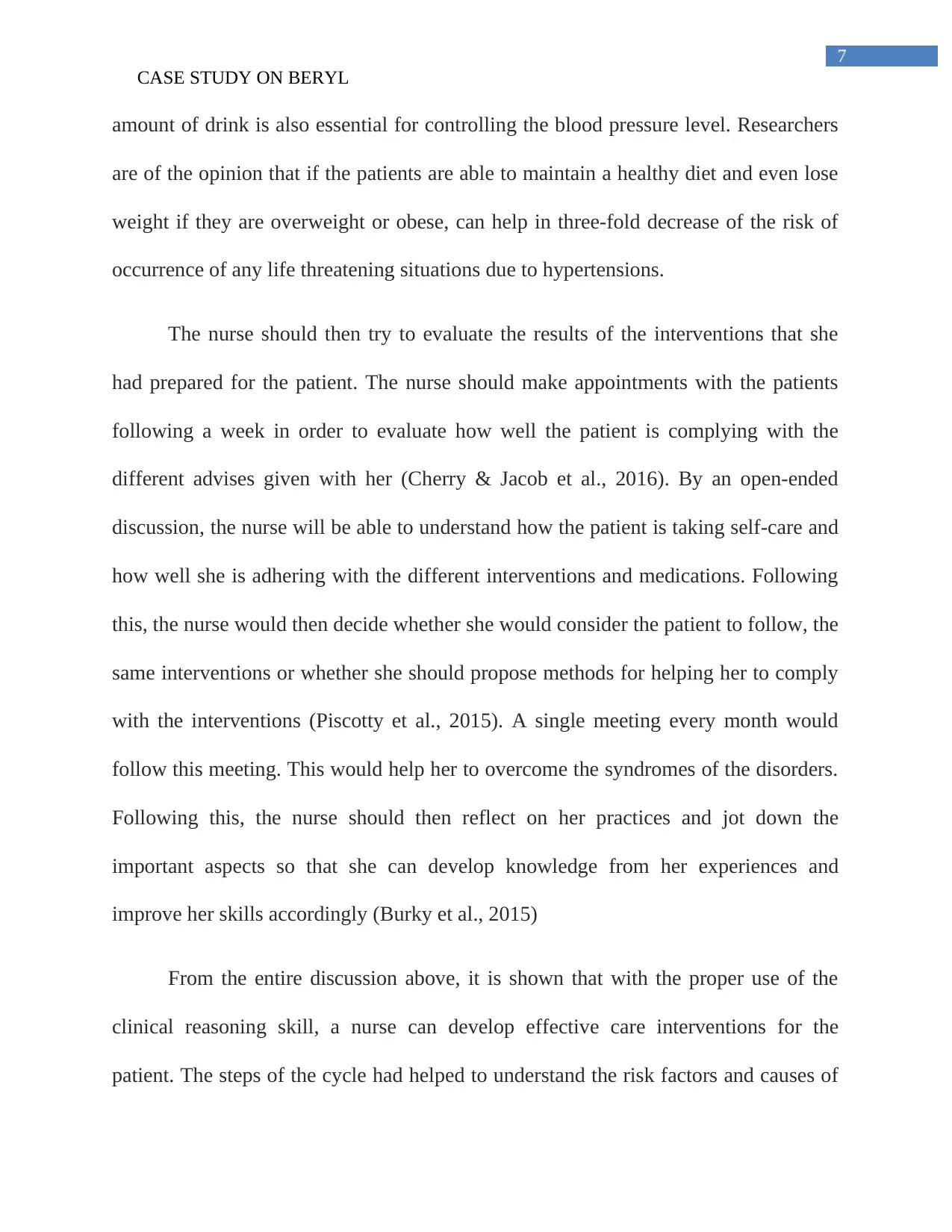
7
CASE STUDY ON BERYL
amount of drink is also essential for controlling the blood pressure level. Researchers
are of the opinion that if the patients are able to maintain a healthy diet and even lose
weight if they are overweight or obese, can help in three-fold decrease of the risk of
occurrence of any life threatening situations due to hypertensions.
The nurse should then try to evaluate the results of the interventions that she
had prepared for the patient. The nurse should make appointments with the patients
following a week in order to evaluate how well the patient is complying with the
different advises given with her (Cherry & Jacob et al., 2016). By an open-ended
discussion, the nurse will be able to understand how the patient is taking self-care and
how well she is adhering with the different interventions and medications. Following
this, the nurse would then decide whether she would consider the patient to follow, the
same interventions or whether she should propose methods for helping her to comply
with the interventions (Piscotty et al., 2015). A single meeting every month would
follow this meeting. This would help her to overcome the syndromes of the disorders.
Following this, the nurse should then reflect on her practices and jot down the
important aspects so that she can develop knowledge from her experiences and
improve her skills accordingly (Burky et al., 2015)
From the entire discussion above, it is shown that with the proper use of the
clinical reasoning skill, a nurse can develop effective care interventions for the
patient. The steps of the cycle had helped to understand the risk factors and causes of
CASE STUDY ON BERYL
amount of drink is also essential for controlling the blood pressure level. Researchers
are of the opinion that if the patients are able to maintain a healthy diet and even lose
weight if they are overweight or obese, can help in three-fold decrease of the risk of
occurrence of any life threatening situations due to hypertensions.
The nurse should then try to evaluate the results of the interventions that she
had prepared for the patient. The nurse should make appointments with the patients
following a week in order to evaluate how well the patient is complying with the
different advises given with her (Cherry & Jacob et al., 2016). By an open-ended
discussion, the nurse will be able to understand how the patient is taking self-care and
how well she is adhering with the different interventions and medications. Following
this, the nurse would then decide whether she would consider the patient to follow, the
same interventions or whether she should propose methods for helping her to comply
with the interventions (Piscotty et al., 2015). A single meeting every month would
follow this meeting. This would help her to overcome the syndromes of the disorders.
Following this, the nurse should then reflect on her practices and jot down the
important aspects so that she can develop knowledge from her experiences and
improve her skills accordingly (Burky et al., 2015)
From the entire discussion above, it is shown that with the proper use of the
clinical reasoning skill, a nurse can develop effective care interventions for the
patient. The steps of the cycle had helped to understand the risk factors and causes of
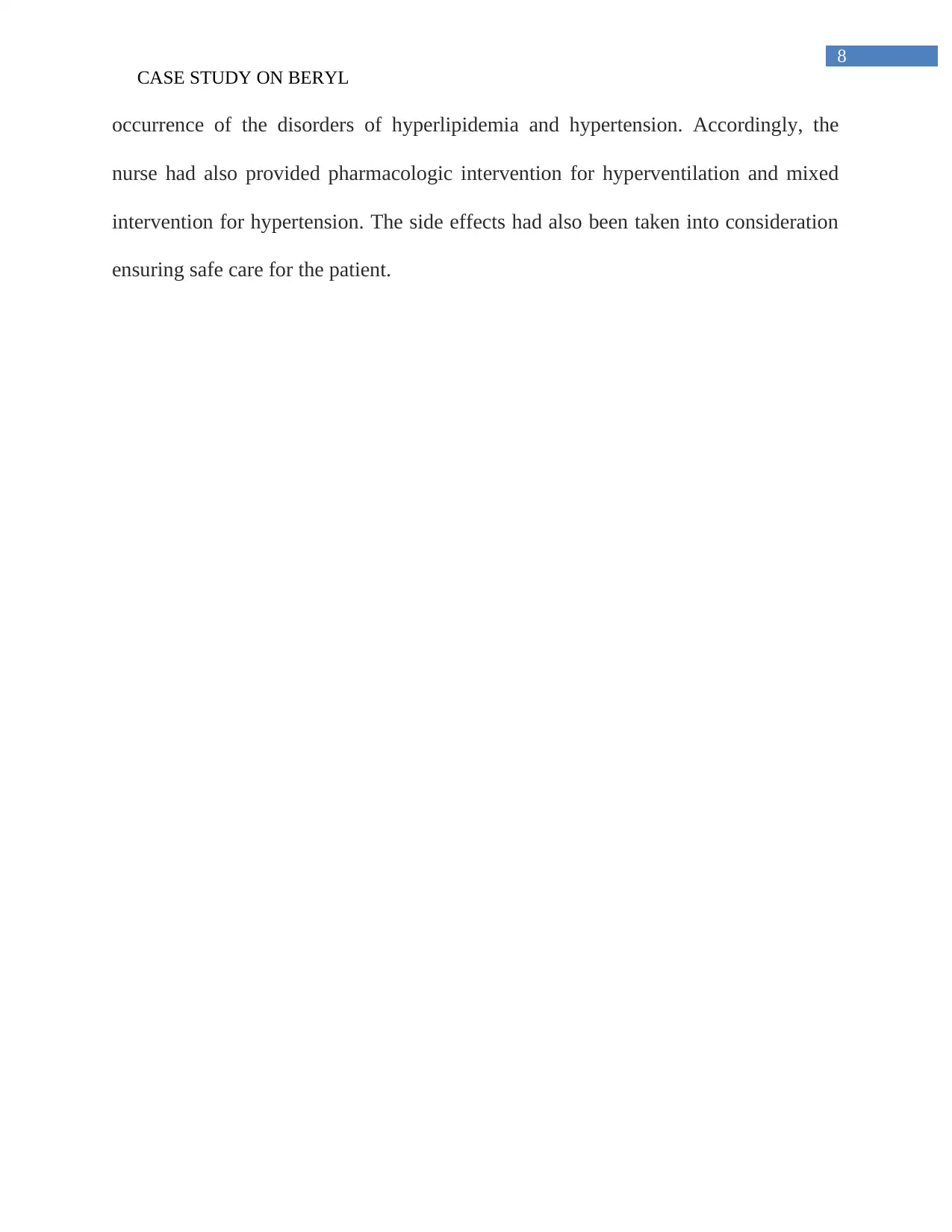
8
CASE STUDY ON BERYL
occurrence of the disorders of hyperlipidemia and hypertension. Accordingly, the
nurse had also provided pharmacologic intervention for hyperventilation and mixed
intervention for hypertension. The side effects had also been taken into consideration
ensuring safe care for the patient.
CASE STUDY ON BERYL
occurrence of the disorders of hyperlipidemia and hypertension. Accordingly, the
nurse had also provided pharmacologic intervention for hyperventilation and mixed
intervention for hypertension. The side effects had also been taken into consideration
ensuring safe care for the patient.
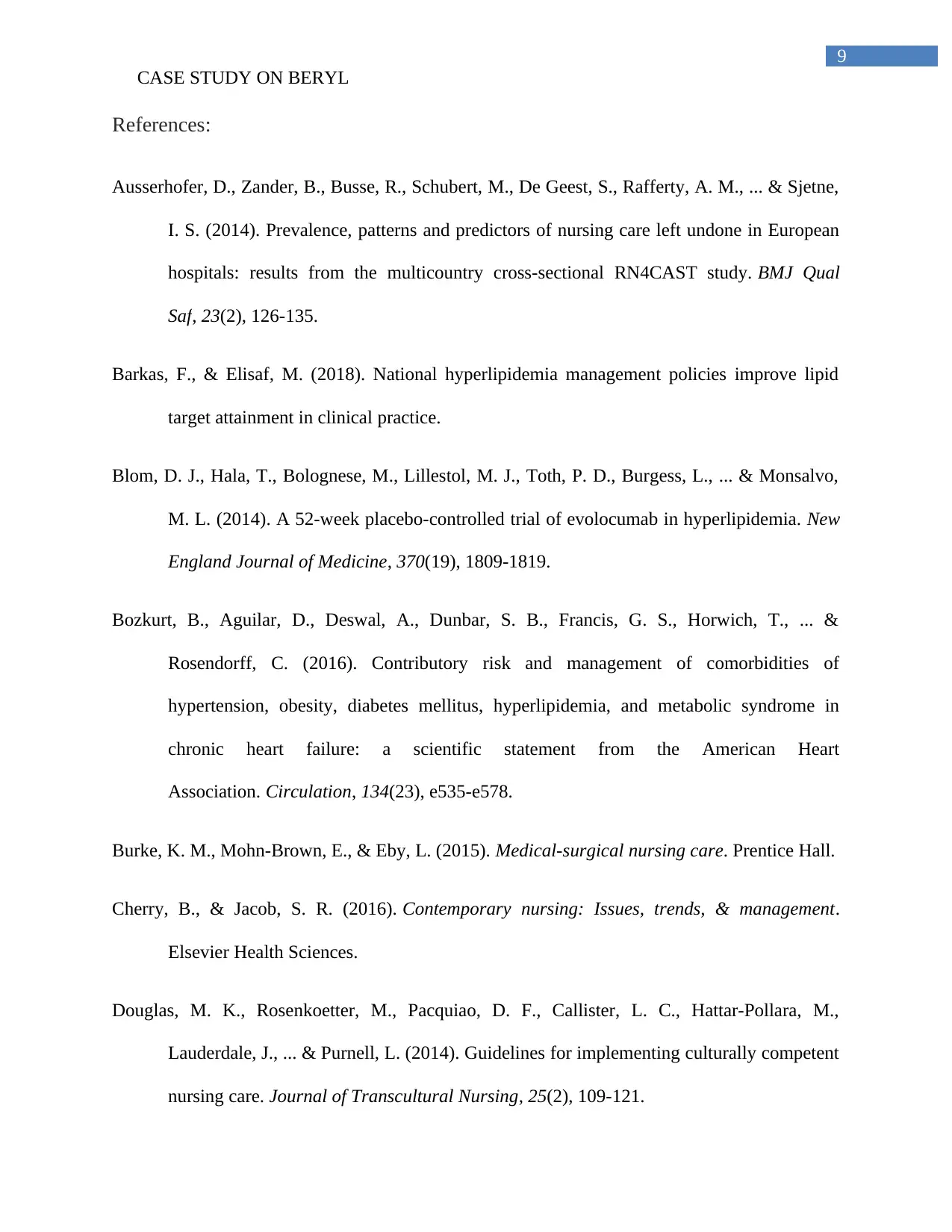
9
CASE STUDY ON BERYL
References:
Ausserhofer, D., Zander, B., Busse, R., Schubert, M., De Geest, S., Rafferty, A. M., ... & Sjetne,
I. S. (2014). Prevalence, patterns and predictors of nursing care left undone in European
hospitals: results from the multicountry cross-sectional RN4CAST study. BMJ Qual
Saf, 23(2), 126-135.
Barkas, F., & Elisaf, M. (2018). National hyperlipidemia management policies improve lipid
target attainment in clinical practice.
Blom, D. J., Hala, T., Bolognese, M., Lillestol, M. J., Toth, P. D., Burgess, L., ... & Monsalvo,
M. L. (2014). A 52-week placebo-controlled trial of evolocumab in hyperlipidemia. New
England Journal of Medicine, 370(19), 1809-1819.
Bozkurt, B., Aguilar, D., Deswal, A., Dunbar, S. B., Francis, G. S., Horwich, T., ... &
Rosendorff, C. (2016). Contributory risk and management of comorbidities of
hypertension, obesity, diabetes mellitus, hyperlipidemia, and metabolic syndrome in
chronic heart failure: a scientific statement from the American Heart
Association. Circulation, 134(23), e535-e578.
Burke, K. M., Mohn-Brown, E., & Eby, L. (2015). Medical-surgical nursing care. Prentice Hall.
Cherry, B., & Jacob, S. R. (2016). Contemporary nursing: Issues, trends, & management.
Elsevier Health Sciences.
Douglas, M. K., Rosenkoetter, M., Pacquiao, D. F., Callister, L. C., Hattar-Pollara, M.,
Lauderdale, J., ... & Purnell, L. (2014). Guidelines for implementing culturally competent
nursing care. Journal of Transcultural Nursing, 25(2), 109-121.
CASE STUDY ON BERYL
References:
Ausserhofer, D., Zander, B., Busse, R., Schubert, M., De Geest, S., Rafferty, A. M., ... & Sjetne,
I. S. (2014). Prevalence, patterns and predictors of nursing care left undone in European
hospitals: results from the multicountry cross-sectional RN4CAST study. BMJ Qual
Saf, 23(2), 126-135.
Barkas, F., & Elisaf, M. (2018). National hyperlipidemia management policies improve lipid
target attainment in clinical practice.
Blom, D. J., Hala, T., Bolognese, M., Lillestol, M. J., Toth, P. D., Burgess, L., ... & Monsalvo,
M. L. (2014). A 52-week placebo-controlled trial of evolocumab in hyperlipidemia. New
England Journal of Medicine, 370(19), 1809-1819.
Bozkurt, B., Aguilar, D., Deswal, A., Dunbar, S. B., Francis, G. S., Horwich, T., ... &
Rosendorff, C. (2016). Contributory risk and management of comorbidities of
hypertension, obesity, diabetes mellitus, hyperlipidemia, and metabolic syndrome in
chronic heart failure: a scientific statement from the American Heart
Association. Circulation, 134(23), e535-e578.
Burke, K. M., Mohn-Brown, E., & Eby, L. (2015). Medical-surgical nursing care. Prentice Hall.
Cherry, B., & Jacob, S. R. (2016). Contemporary nursing: Issues, trends, & management.
Elsevier Health Sciences.
Douglas, M. K., Rosenkoetter, M., Pacquiao, D. F., Callister, L. C., Hattar-Pollara, M.,
Lauderdale, J., ... & Purnell, L. (2014). Guidelines for implementing culturally competent
nursing care. Journal of Transcultural Nursing, 25(2), 109-121.
Secure Best Marks with AI Grader
Need help grading? Try our AI Grader for instant feedback on your assignments.
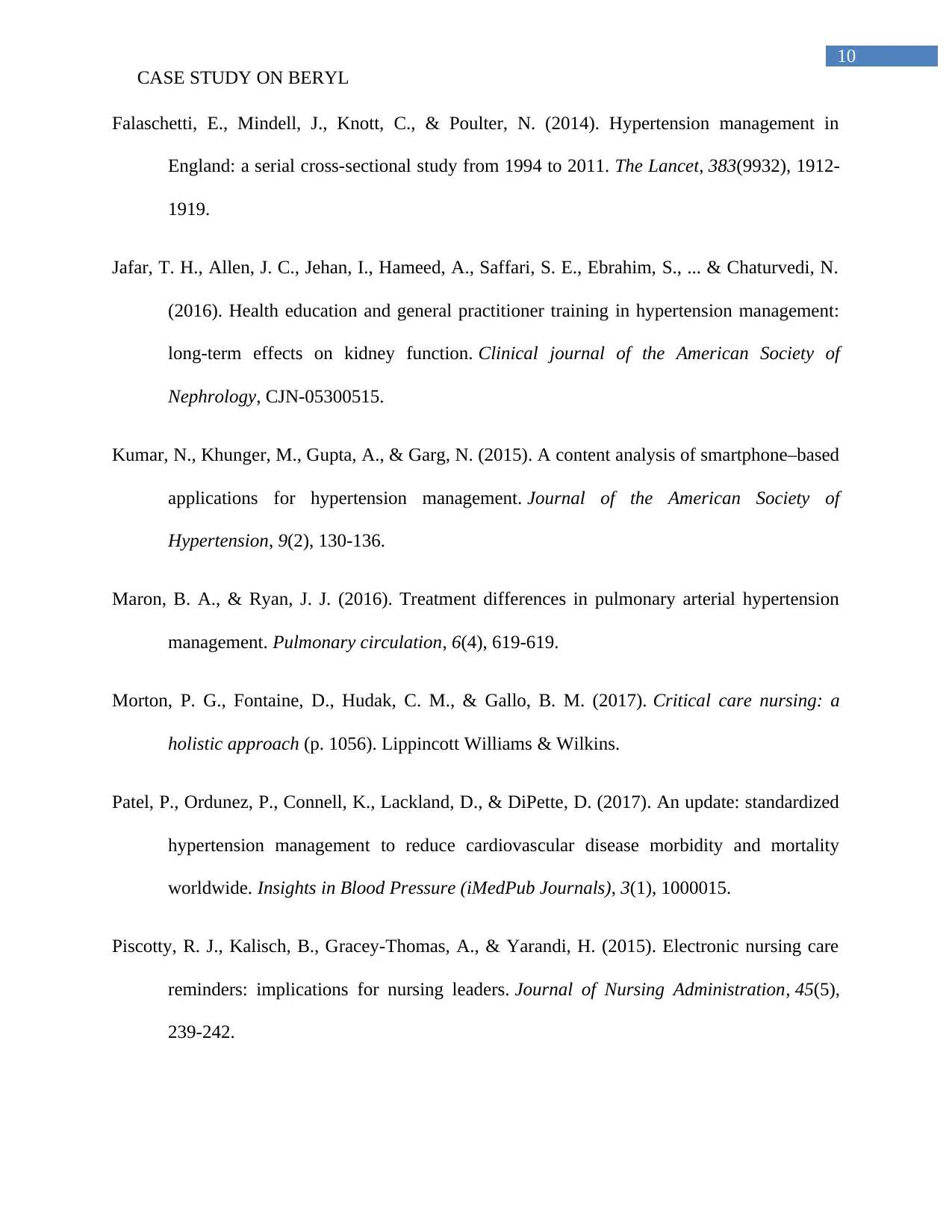
10
CASE STUDY ON BERYL
Falaschetti, E., Mindell, J., Knott, C., & Poulter, N. (2014). Hypertension management in
England: a serial cross-sectional study from 1994 to 2011. The Lancet, 383(9932), 1912-
1919.
Jafar, T. H., Allen, J. C., Jehan, I., Hameed, A., Saffari, S. E., Ebrahim, S., ... & Chaturvedi, N.
(2016). Health education and general practitioner training in hypertension management:
long-term effects on kidney function. Clinical journal of the American Society of
Nephrology, CJN-05300515.
Kumar, N., Khunger, M., Gupta, A., & Garg, N. (2015). A content analysis of smartphone–based
applications for hypertension management. Journal of the American Society of
Hypertension, 9(2), 130-136.
Maron, B. A., & Ryan, J. J. (2016). Treatment differences in pulmonary arterial hypertension
management. Pulmonary circulation, 6(4), 619-619.
Morton, P. G., Fontaine, D., Hudak, C. M., & Gallo, B. M. (2017). Critical care nursing: a
holistic approach (p. 1056). Lippincott Williams & Wilkins.
Patel, P., Ordunez, P., Connell, K., Lackland, D., & DiPette, D. (2017). An update: standardized
hypertension management to reduce cardiovascular disease morbidity and mortality
worldwide. Insights in Blood Pressure (iMedPub Journals), 3(1), 1000015.
Piscotty, R. J., Kalisch, B., Gracey-Thomas, A., & Yarandi, H. (2015). Electronic nursing care
reminders: implications for nursing leaders. Journal of Nursing Administration, 45(5),
239-242.
CASE STUDY ON BERYL
Falaschetti, E., Mindell, J., Knott, C., & Poulter, N. (2014). Hypertension management in
England: a serial cross-sectional study from 1994 to 2011. The Lancet, 383(9932), 1912-
1919.
Jafar, T. H., Allen, J. C., Jehan, I., Hameed, A., Saffari, S. E., Ebrahim, S., ... & Chaturvedi, N.
(2016). Health education and general practitioner training in hypertension management:
long-term effects on kidney function. Clinical journal of the American Society of
Nephrology, CJN-05300515.
Kumar, N., Khunger, M., Gupta, A., & Garg, N. (2015). A content analysis of smartphone–based
applications for hypertension management. Journal of the American Society of
Hypertension, 9(2), 130-136.
Maron, B. A., & Ryan, J. J. (2016). Treatment differences in pulmonary arterial hypertension
management. Pulmonary circulation, 6(4), 619-619.
Morton, P. G., Fontaine, D., Hudak, C. M., & Gallo, B. M. (2017). Critical care nursing: a
holistic approach (p. 1056). Lippincott Williams & Wilkins.
Patel, P., Ordunez, P., Connell, K., Lackland, D., & DiPette, D. (2017). An update: standardized
hypertension management to reduce cardiovascular disease morbidity and mortality
worldwide. Insights in Blood Pressure (iMedPub Journals), 3(1), 1000015.
Piscotty, R. J., Kalisch, B., Gracey-Thomas, A., & Yarandi, H. (2015). Electronic nursing care
reminders: implications for nursing leaders. Journal of Nursing Administration, 45(5),
239-242.
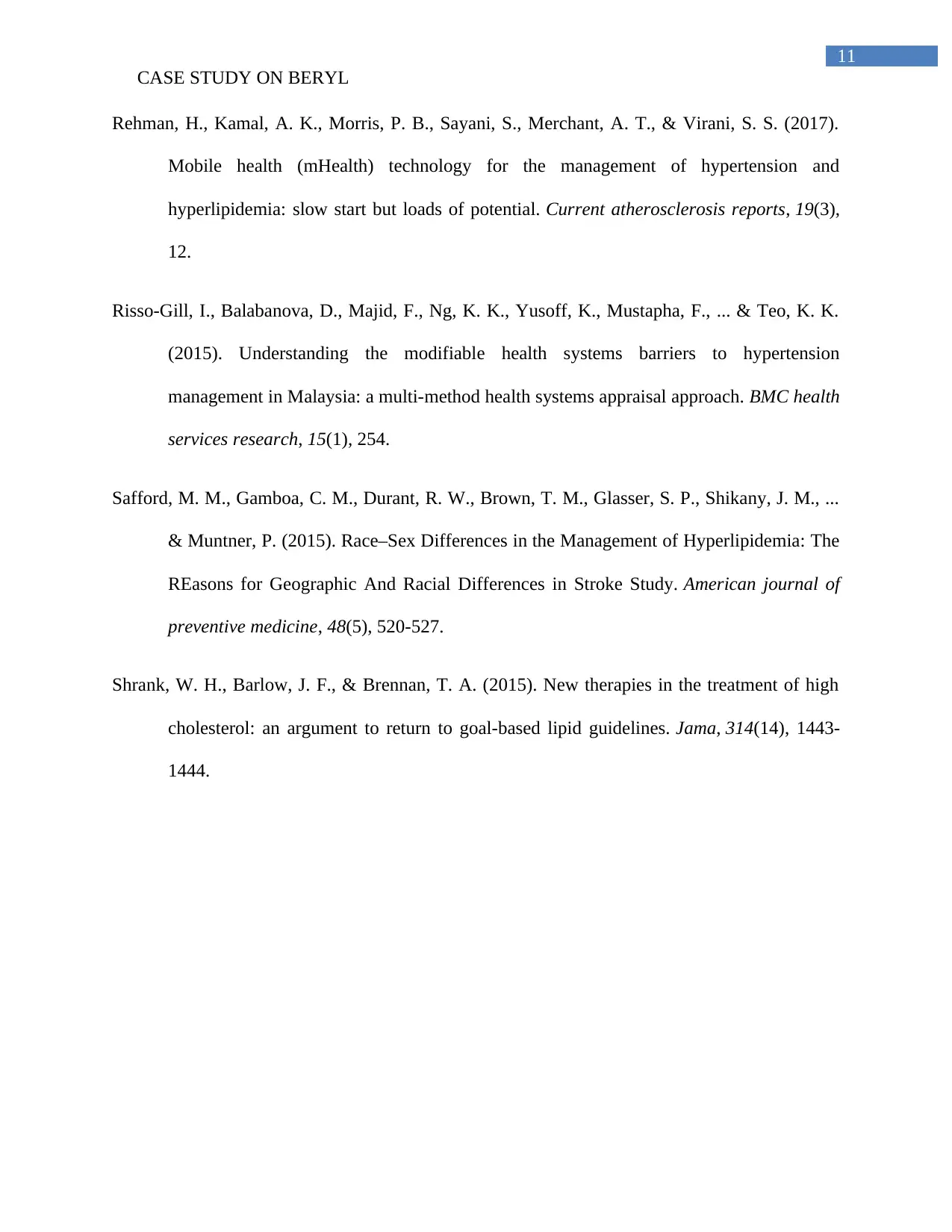
11
CASE STUDY ON BERYL
Rehman, H., Kamal, A. K., Morris, P. B., Sayani, S., Merchant, A. T., & Virani, S. S. (2017).
Mobile health (mHealth) technology for the management of hypertension and
hyperlipidemia: slow start but loads of potential. Current atherosclerosis reports, 19(3),
12.
Risso-Gill, I., Balabanova, D., Majid, F., Ng, K. K., Yusoff, K., Mustapha, F., ... & Teo, K. K.
(2015). Understanding the modifiable health systems barriers to hypertension
management in Malaysia: a multi-method health systems appraisal approach. BMC health
services research, 15(1), 254.
Safford, M. M., Gamboa, C. M., Durant, R. W., Brown, T. M., Glasser, S. P., Shikany, J. M., ...
& Muntner, P. (2015). Race–Sex Differences in the Management of Hyperlipidemia: The
REasons for Geographic And Racial Differences in Stroke Study. American journal of
preventive medicine, 48(5), 520-527.
Shrank, W. H., Barlow, J. F., & Brennan, T. A. (2015). New therapies in the treatment of high
cholesterol: an argument to return to goal-based lipid guidelines. Jama, 314(14), 1443-
1444.
CASE STUDY ON BERYL
Rehman, H., Kamal, A. K., Morris, P. B., Sayani, S., Merchant, A. T., & Virani, S. S. (2017).
Mobile health (mHealth) technology for the management of hypertension and
hyperlipidemia: slow start but loads of potential. Current atherosclerosis reports, 19(3),
12.
Risso-Gill, I., Balabanova, D., Majid, F., Ng, K. K., Yusoff, K., Mustapha, F., ... & Teo, K. K.
(2015). Understanding the modifiable health systems barriers to hypertension
management in Malaysia: a multi-method health systems appraisal approach. BMC health
services research, 15(1), 254.
Safford, M. M., Gamboa, C. M., Durant, R. W., Brown, T. M., Glasser, S. P., Shikany, J. M., ...
& Muntner, P. (2015). Race–Sex Differences in the Management of Hyperlipidemia: The
REasons for Geographic And Racial Differences in Stroke Study. American journal of
preventive medicine, 48(5), 520-527.
Shrank, W. H., Barlow, J. F., & Brennan, T. A. (2015). New therapies in the treatment of high
cholesterol: an argument to return to goal-based lipid guidelines. Jama, 314(14), 1443-
1444.
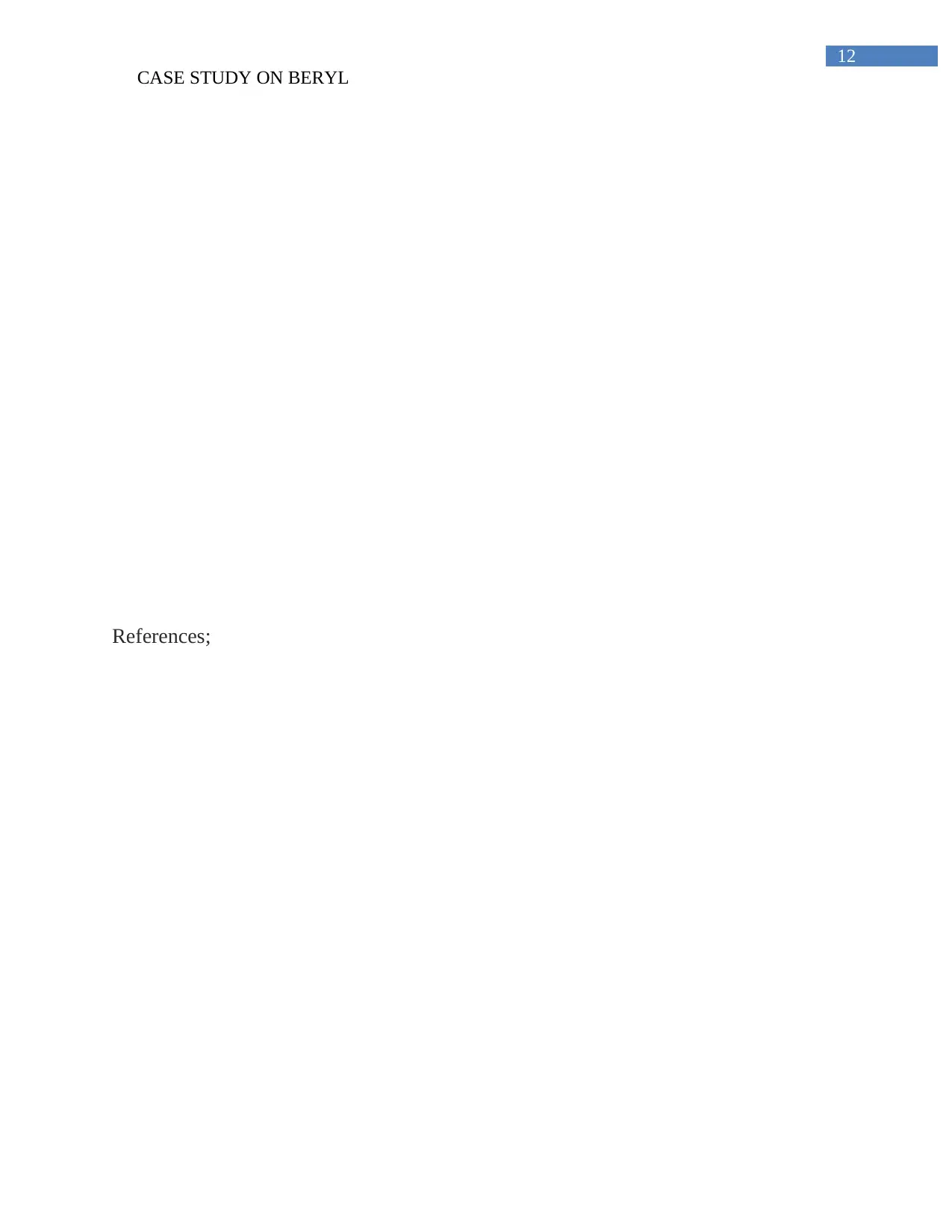
12
CASE STUDY ON BERYL
References;
CASE STUDY ON BERYL
References;
1 out of 13
Related Documents
Your All-in-One AI-Powered Toolkit for Academic Success.
+13062052269
info@desklib.com
Available 24*7 on WhatsApp / Email
![[object Object]](/_next/static/media/star-bottom.7253800d.svg)
Unlock your academic potential
© 2024 | Zucol Services PVT LTD | All rights reserved.





